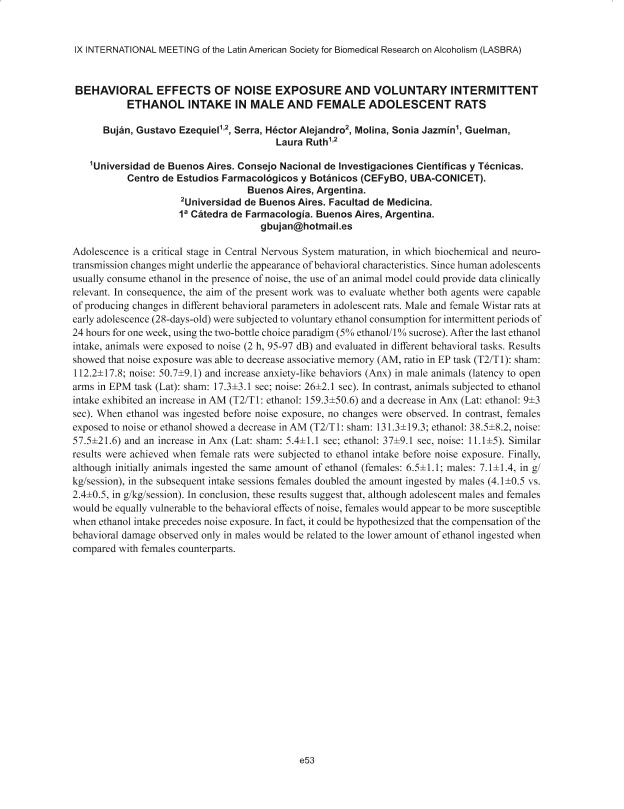Mostrar el registro sencillo del ítem
dc.contributor.author
Buján, Gustavo Ezequiel

dc.contributor.author
Serra, Hector Alejandro
dc.contributor.author
Molina, Sonia Jazmín

dc.contributor.author
Guelman, Laura Ruth

dc.date.available
2023-03-31T17:27:26Z
dc.date.issued
2019
dc.identifier.citation
Behavioral effects of noise exposure and voluntary intermittent ethanol intake in male and female adolescent rats; IX Inintenational Meeting of the Latin American Society for Biomedical Research on Alcoholism; Cordoba; Argentina; 2019; 1-1
dc.identifier.uri
http://hdl.handle.net/11336/192353
dc.description.abstract
Adolescence is a critical stage in Central Nervous System maturation, in which biochemical and neurotransmission changes might underlie the appearance of behavioral characteristics. Since human adolescents usually consume ethanol in the presence of noise, the use of an animal model could provide data clinically relevant. In consequence, the aim of the present work was to evaluate whether both agents were capable of producing changes in different behavioral parameters in adolescent rats.Male and female Wistar rats at early adolescence (28-days-old) were subjected to voluntary ethanol consumption for intermittent periods of 24 hours for one week, using the two-bottle choice paradigm (5% ethanol/1% sucrose). After the last ethanol intake, animals were exposed to noise (2 h, 95-97 dB) and evaluated in different behavioral tasks.Results showed that noise exposure was able to decrease associative memory (AM, ratio in EP task (T2/T1): sham: 112.217.8; noise: 50.79.1) and increase anxiety-like behaviors (Anx) in male animals (latency to open arms in EPM task (Lat): sham: 17.33.1 sec; noise: 262.1 sec). In contrast, animals subjected to ethanol intake exhibited an increase in AM (T2/T1: ethanol: 159.350.6) and a decrease in Anx (Lat: ethanol: 93 sec). When ethanol was ingested before noise exposure, no changes were observed. In contrast, females exposed to noise or ethanol showed a decrease in AM (T2/T1: sham: 131.319.3; ethanol: 38.58.2, noise: 57.521.6) and an increase in Anx (Lat: sham: 5.41.1 sec; ethanol: 379.1 sec, noise: 11.15). Similar results were achieved when female rats were subjected to ethanol intake before noise exposure. Finally, although initially animals ingested the same amount of ethanol (females: 6.51.1; males: 7.11.4, in g/kg/session), in the subsequent intake sessions females doubled the amount ingested by males (4.10.5 vs. 2.40.5, in g/kg/session).In conclusion, these results suggest that, although adolescent males and females would be equally vulnerable to the behavioral effects of noise, females would appear to be more susceptible when ethanol intake precedes noise exposure. In fact, it could be hypothesized that the compensation of the behavioral damage observed only in males would be related to the lower amount of ethanol ingested when compared with females counterparts.
dc.format
application/pdf
dc.language.iso
eng
dc.publisher
Latin American Society for Biomedical Research on Alcoholism
dc.rights
info:eu-repo/semantics/openAccess
dc.rights.uri
https://creativecommons.org/licenses/by-nc-sa/2.5/ar/
dc.subject
Ethanol intake
dc.subject
Noise exposure
dc.subject
behavioral effects
dc.subject.classification
Neurociencias

dc.subject.classification
Medicina Básica

dc.subject.classification
CIENCIAS MÉDICAS Y DE LA SALUD

dc.title
Behavioral effects of noise exposure and voluntary intermittent ethanol intake in male and female adolescent rats
dc.type
info:eu-repo/semantics/publishedVersion
dc.type
info:eu-repo/semantics/conferenceObject
dc.type
info:ar-repo/semantics/documento de conferencia
dc.date.updated
2022-11-25T00:28:42Z
dc.journal.volume
2
dc.journal.number
1
dc.journal.pagination
1-1
dc.journal.pais
Argentina

dc.journal.ciudad
Cordoba
dc.description.fil
Fil: Buján, Gustavo Ezequiel. Consejo Nacional de Investigaciones Científicas y Técnicas. Oficina de Coordinación Administrativa Houssay. Centro de Estudios Farmacológicos y Botánicos. Universidad de Buenos Aires. Facultad de Medicina. Centro de Estudios Farmacológicos y Botánicos; Argentina
dc.description.fil
Fil: Serra, Hector Alejandro. Universidad de Buenos Aires. Facultad de Medicina. Cátedra de Farmacología; Argentina
dc.description.fil
Fil: Molina, Sonia Jazmín. Consejo Nacional de Investigaciones Científicas y Técnicas. Oficina de Coordinación Administrativa Houssay. Centro de Estudios Farmacológicos y Botánicos. Universidad de Buenos Aires. Facultad de Medicina. Centro de Estudios Farmacológicos y Botánicos; Argentina
dc.description.fil
Fil: Guelman, Laura Ruth. Consejo Nacional de Investigaciones Científicas y Técnicas. Oficina de Coordinación Administrativa Houssay. Centro de Estudios Farmacológicos y Botánicos. Universidad de Buenos Aires. Facultad de Medicina. Centro de Estudios Farmacológicos y Botánicos; Argentina
dc.relation.alternativeid
info:eu-repo/semantics/altIdentifier/url/https://doi.org/10.22374/jfasrp.v2i1.7
dc.conicet.rol
Autor

dc.conicet.rol
Autor

dc.conicet.rol
Autor

dc.conicet.rol
Autor

dc.coverage
Internacional
dc.type.subtype
Reunión
dc.description.nombreEvento
IX Inintenational Meeting of the Latin American Society for Biomedical Research on Alcoholism
dc.date.evento
2019-11-07
dc.description.ciudadEvento
Cordoba
dc.description.paisEvento
Argentina

dc.type.publicacion
Journal
dc.description.institucionOrganizadora
Latin American Society for Biomedical Research on Alcoholism
dc.source.revista
Journal of Fetal Alcohol Spectrum Risk and Prevention
dc.date.eventoHasta
2019-11-09
dc.type
Reunión
Archivos asociados
